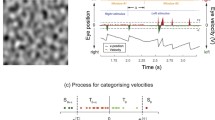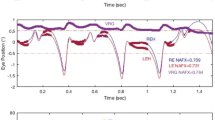Abstract
• Background: It was previously shown that optokinetic nystagmus (OKN) gain (eye velocity/target velocity) increases with increasing target luminance at a constant target velocity during scotopic vision. Eye velocity was defined as the amplitude of the eye jerk divided by the period time. The dependence of frequency and amplitude of eye jerks in scotopic OKN on target luminance and velocity was investigated in the present study • Method: A total of nine subjects were examined for OKN with various target luminance and velocities under scotopic conditions. Monocular OKN was elicited by a vertical grating projected in a hemisphere. The eye movement was recorded by DC EOG • Results: It was found that when a constant target velocity is used, both the frequency and amplitude of eye jerks increase with an exponential decline as target luminance increases. The maximum frequency and amplitude obtained at high target luminance are independent of target velocity. The exponential decline constants for both frequency and amplitude decrease with increased target velocity • Conclusion: Both frequency and amplitude of eye jerks are responsible for changes in OKN gain when target luminance and velocity change.
Similar content being viewed by others
References
Bergman F, Costin A, Gutman J, Chaimovitz M (1965) The inhibitory effect of light on central and optokinetic nystagmus in the rabbit. Confin Neurol 25:403–412
Collewijn H (1971) The optokinetic system of the rabbit. Doc Ophthalmol 30:205–226
Collins WE, Schroeder DJ, Rice N, Mertens RA, Kranz G (1970) Some characteristics of optokinetic eye movement patterns: a comparative study. Aerospace Med (November) 1251–1262
Ehlers H (1925) On optically elicited nystagmus. Acta Ophthalmol 3:54–71
Honrubia V, Downey WP, Mitchell DP, A B, Ward PH (1968) Experimental studies on optokinetic nystagmus. Acta Oto Laryngol 65:441–448
Miyoshi T, Pfaltz CR (1973) Upon the correlation between the optokinetic stimulus and the induced optokinetic nystagmus. 1. Influence of O. K. targets. ORL 35:52–64
Miyoshi T, Pfaltz CR (1973) Studies on the correlation between optokinetic stimulus and induced nystagmus. 2. The influence of the visual fields upon the optokinetic response. ORL 35:350–362
Snedecor GW, Cochran WG (1980) A general method of fitting non-linear regression. In: Snedecor GW, Cochran WG (eds) Statistical methods, 7th edn. Iowa University Press, Ames, pp 407–409
Ter Braak JWG (1936) Untersuchungen über Optokinetic Nystagmus. Arch Neerl Physiol 21:309–376
Wang L (1991) The relationship of luminous intensity and velocity for pattern perception and maximum OKN elicitation. Vision Res 31(9):1601–1609
Wang L, Söderberg PG, Tengroth B (1993) Influence of target direction, luminance and velocity on monocular horizontal optokinetic nystagmus. Acta Ophthalmol 71:578–585
Wheeless LL, Cohen GH, Boynton RM (1967) Luminance as a parameter of the eye movement control system. J Opt Soc Am 57(3): 394–400
Author information
Authors and Affiliations
Rights and permissions
About this article
Cite this article
Wang, L., Soderberg, P.G. & Wang, L. Frequency and amplitude in scotopically stimulated optokinetic nystagmus. Graefe's Arch Clin Exp Ophthalmol 233, 8–12 (1995). https://doi.org/10.1007/BF00177779
Received:
Accepted:
Issue Date:
DOI: https://doi.org/10.1007/BF00177779




